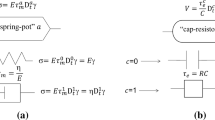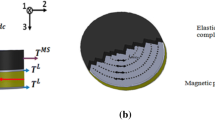Abstract
Polymeric hybrid magnetic films composed of iron oxide nanoparticles and polyvinyl butyral (PVB) were synthesized and studied by a fractional calculus approach. Iron oxide nanoparticles were synthesized in situ from a polymeric hybrid precursor composed of Fe+2 and PVB. These polymeric hybrid magnetic films (PVB/Fe2O3) could carry out functions as actuators or sensors in electronic or mechatronic devices. But, for this purpose, it is required a study of the mechanical relaxation processes displayed in the polymer matrix. The synthesis of iron oxide nanoparticles into PVB was confirmed by HRTEM, XRD and FTIR analysis. The main goal of this work is the study of the effect of iron oxide nanoparticles on the α-relaxation for three PVB samples with a different mass average molar mass. Experimental measurements of the complex modulus, \(\left( {E^{*} = E^{{\prime }} + iE^{\prime \prime } } \right)\), were obtained by dynamic mechanical analysis (DMA) to identify the α-relaxation for each analyzed sample. Experimental isochronal curves of \(E^{\prime }\) and \(E^{\prime \prime }\) were compared with theoretical curves of \(E^{\prime } \left( T \right)\) and \(E^{\prime \prime } \left( T \right)\) computed by the fractional Zener model (FZM). An agreement between experiments and fractional model predictions has been achieved. The effect of fractional parameters (\(a\) and \(b\)) of the FZM was related to molecular motions associated with this relaxation process. The cooperative motions of chains segments were observed in all analyzed samples, and \(b > a\); this means that when temperature increases, the molecular mobility (energy dissipation) also increases. The matching between PVB matrix and the Fe2O3/PVB films showed that Fe2O3 nanoparticles decreases the molecular mobility of PVB; this effect is more pronounced at temperatures above \(T_{\text{g}}\).









Similar content being viewed by others
References
Reyes-Melo ME, Puente-Córdova JG, López-Walle B, Torres-Castro A, García-Loera AF. Synthesis and characterization of a polymeric magnetic hybrid material composed of iron oxide nanoparticles and polyvinyl butyral. Ingeniería investigación y tecnología. 2018;XIX:113–23.
López-Walle B, Reyes-Melo ME. Characterization and dynamics of polymer microactuators. In: Micky R, editor. Smart materials-based actuators at the micro/nano-scale. Characterization, control, and applications. New York: Springer; 2013. p. 15–39.
Llamas-Hernández Mayra, López-Walle Beatriz, Rakotondrabe Micky, Reyes-Melo Edgar. Dynamic behavior of magnetic hybrid films of polyvinyl butyral/iron oxide nanoparticles (PVB/Fe2O3) for their control as microactuators. Physica B Phys Condens Matter. 2018;549:113–7.
Iwasaki K, Takeda Y, Iwata F. Nanomanipulator based on a high-speed atomic force microscope capable of controlling a cantilever loading force using a magnetic solenoid. IEEE MHS. 2016. https://doi.org/10.1109/mhs.2016.7824205.
Kobayashi K, Ikuta K. 3D magnetic microactuator made of newly developed magnetically modified photocurable polymer and application to swimming micromachine and microscrewpump. IEEE MEMS. 2009. https://doi.org/10.1109/memsys.2009.4805306.
Kobayashi K, Ikuta K. Magnetic microactuator with neutral buoyancy and 3D fabrication of cell size magnetized structure. IEEE ICRA. 2012. https://doi.org/10.1109/icra.2012.6225113.
Anansa A, Raju R. Hysteretic buckling for actuation of magnet–polymer composites. Macromol Chem Phys. 2015;216:1594–602.
Kim J, Chung SE, Choi SE, Lee H, Kim J, Kwon S. Programming magnetic anisotropy in polymeric microactuators. Nat Mater. 2011;10:747–52.
Wei W, Wang Z. Investigation of Magnetic nanoparticle motion under a gradient magnetic field by an electromagnet. J Nanomater. 2018;2018:1–5.
Zhou ZM, David DJ, Macknight WJ, Karasz FE. Synthesis characterization and miscibility polyvinyl butyrals of varying alcohol contents. Turk J Chem. 1997;21:229–38.
Xi-Xi Q, Zhi-Lin C. Application of ionic liquids as a catalyst in the synthesis of polyvinyl butyral (PVB) polymer. Chinese Chem Lett. 2016;27:145–8.
Carini G Jr, Carini G, d’Angelo G, Federico M, di Marco G, Bartolotta A. Enhancing the molecular cooperativity of polyvinyl butyral using liquid additives. J Polym Sci B Polym Phys. 2018;56:340–6.
Matsuoka S. Relaxation phenomena in polymers. Munich: Hanser Publisher; 1992.
Reyes-Melo ME, Martínez-Vega JJ, Guerrero-Salazar CA, Ortiz-Méndez U. Mechanical and dielectric relaxation phenomena of poly(ethylene-2,6-napthalene dicarboxylate) by fractional calculus approach. J Appl Polym Sci. 2006;102:3354–68.
Puente-Córdova JG, Reyes-Melo ME, Palacios-Pineda LM, Martínez-Perales IA, Martínez-Romero O, Elías-Zúñiga A. Fabrication and characterization of isotropic and anisotropic magnetorheological elastomers, based on silicone rubber and carbonyl iron microparticles. Polymers. 2018;10:1–13.
Reyes-Melo E, Martinez-Vega J, Guerrero-Salazar C, Ortiz-Méndez U. On the modeling of the dynamic-elastic modulus for polymer materials under isochronal conditions. J Appl Polym Sci. 2004;94:657–70.
Reyes-Melo ME, González-González VA, Guerrero-Salazar CA, García-Cavazos F, Ortiz-Méndez U. Application of fractional calculus to the modeling of the complex rheological behavior of polymers: from the glass transition to flow behavior. I. The theoretical model. J Appl Polym Sci. 2008;108:731–7.
Bartolotta A, Carini G Jr, Carini G, di Marco G, Tripodo G. Subglass cooperative mechanical relaxations and activation entropy in heterocyclic polymer networks. Macromolecules. 2010;43:4798–804.
Pazmiño-Betancourt BA, Douglas JF, Starr FW. Fragility and cooperative motion in a glass-forming polymer–nanoparticle composite. Soft Matter. 2013;9:241–54.
Reyes-Melo ME, Rentería-Baltiérrez FY, López-Walle B, López-Cuellar E, de Araujo CJ. Application of fractional calculus to modeling the dynamic mechanical analysis of a NiTi SMA ribbon. J Therm Anal Calorim. 2016;126:593–9.
Fang CQ, Sun HY, Gu JP. Application of fractional calculus methods to viscoelastic response of amorphous shape memory polymers. J Mech. 2015;31:427–32.
Ionescu C, Lopes A, Copot D, Machado JAT, Bates JHT. The role of fractional calculus in modeling biological phenomena: a review. Commun Nonlinear Sci Numer Simul. 2017;51:141–59.
Alcoutlabi M, Martinez-Vega JJ. Modeling of the viscoelastic behavior of amorphous polymers by the differential and integration fractional method: the relaxation spectrum H(τ). Polymer. 2003;44:7199–208.
Matusoka S. Entropy, free volume, and cooperative relaxation. J Res Natl Inst Stand Technol. 1997;102:213–28.
Ngai KL. Relation between some secondary relaxations and the α relaxations in glass-forming materials according to the coupling model. J Chem Phys. 1998;16:6982–94.
Luna-Martínez JF, Reyes-Melo E, González-González V, Guerrero-Salazar C, Torres-Castro A, Sepúlveda-Guzmán S. Synthesis and characterization of a magnetic hybrid material consisting of iron oxide in a carboxymethyl cellulose matrix. J Appl Polym Sci. 2013;127:2325–31.
Kim YJ, Liu YD, Seo Y, Choi HJ. Pickering-emulsion-polymerized polystyrene/Fe2O3 composite particles and their magnetoresponsive characteristics. Langmuir. 2013;29:4959–65.
Ramesh R, Ashok K, Bhalero GM, Ponnusamy S, Muthamizhchelvan C. Synthesis and properties of α-Fe2O3 nanorods. Cryst Res Technol. 2010;45:965–8.
Zhanga LD, Liua WL, Xua WH, Yao JS, Zhao L, Wang XQ, Wu YZ. Synthesis and characterization of superhydrophobic and superparamagnetic film based on maghemite-polystyrene composite nanoparticles. Appl Surf Sci. 2012;259:719–25.
Marinho JZ, Montes RHO, de Moura AP, Longo E, Varela JA, Munoz RAA, Lima RC. Rapid preparation of α-FeOOH and α-Fe2O3 nanostructures by microwave heating and their application in electrochemical sensors. Mater Res Bull. 2014;49:572–6.
Aliahmad M, Nasiri MN. Synthesis of maghemite (γ-Fe2O3) nanoparticles by thermal-decomposition of magnetite (Fe3O4) nanoparticles. Mater Sci Poland. 2013;31:264–8.
Park BJ, You JL, Choi HJ, Park SY, Lee BY. Synthesis and Magnetorheological characterization of magnetite nanoparticle and poly(vinyl butyral) composite. IEEE Trans Magn. 2009;45:2460–3.
Lian F, Wen Y, Ren Y, Guan HY. A novel PVB based polymer membrane and its application in gel polymer electrolytes for lithium-ion batteries. J Membr Sci. 2014;456:42–8.
Lemos MF, Bohn MA. DMA of polyester-based polyurethane elastomers for composite rocket propellants containing different energetic plasticizers. J Therm Anal Calorim. 2016;131:595–600.
Alcoutlabi M, Martínez-Vega JJ. The effect of physical ageing on the relaxation time spectrum of amorphous polymers: the fractional calculus approach. J Mater Sci. 1999;34:2361–9.
Liu B, Xu J, Li Y. Constitutive investigation on viscoelasticity of polyvinyl butyral: experiments based on dynamic mechanical analysis method. Adv Mater Sci Eng. 2014;2014:1–10.
Bower DI. An introduction to polymer physics. 1st ed. Cambridge: Cambridge University Press; 2002.
Author information
Authors and Affiliations
Corresponding author
Additional information
Publisher's Note
Springer Nature remains neutral with regard to jurisdictional claims in published maps and institutional affiliations.
Rights and permissions
About this article
Cite this article
Rentería-Baltiérrez, F.Y., Reyes-Melo, M.E., López-Walle, B. et al. A fractional calculus approach to study mechanical relaxations on hybrid films of Fe2O3 nanoparticles and polyvinyl butyral. J Therm Anal Calorim 139, 113–124 (2020). https://doi.org/10.1007/s10973-019-08369-4
Received:
Accepted:
Published:
Issue Date:
DOI: https://doi.org/10.1007/s10973-019-08369-4




